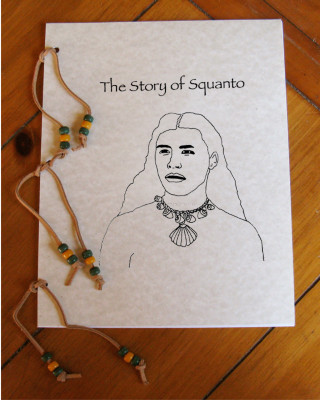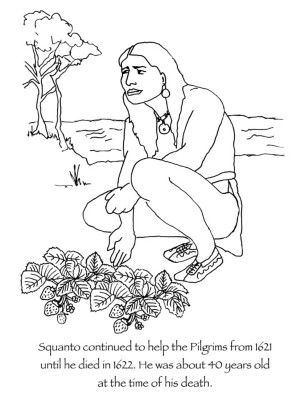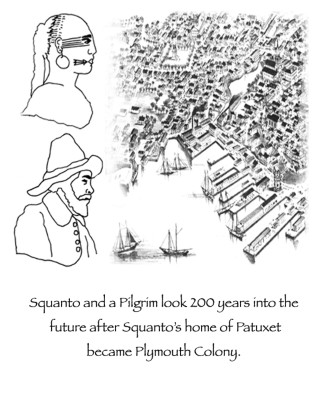An idea of how to make your Squanto Story coloring book
I printed the cover on a parchment looking cover stock paper and printed the coloring pages on regular paper. Then I punched three holes in the cover and coloring pages and tied them together with leather thong. You could also use jute or yarn to attach the cover and pages. Add some beads and tie a knot on the end to keep the beads from slipping off.

We are adding a brief story of Tisquantum, whom most of you know as "Squanto". His story is an inspiration for Thanksgiving and his life demonstrates many virtues such as courage, patience, endurance, compassion, and generosity.
We will also suggest cooperative games that children can play which incorporate the story of Squanto and the virtues and values he demonstrated in his life. We hope this page is of help for all educators and parents.
The coloring book and activities are added below the story.
Paula and Lea

The Story of Squanto
Squanto, whose proper name is Tisquantum, was a member of the Wampanoag Nation and lived with his family and tribe on the eastern shores of the United States. Today Squanto’s tribe, the Wampanoag, live in Massachusetts and Rhode Island.
One day when Squanto was a teenager, a British ship came to these shores and kidnapped him and 3 other members of his family, plus 21 of his relatives from a neighboring village. They were all taken from their homes and sold into slavery in Spain. Squanto was sold to a group of Catholic monks. Luckily, just prior to this time, the Pope of the Catholic religion made a law about slavery which forbid the enslavement of Indigenous peoples of the Americas. The monks obeyed this law, even though they had to pay for Squanto, they never regarded him as a slave and gave him freedom and respect.
After several years with the Spanish monks, Squanto discovered that English ships frequently went to the shores of his homeland. With the help of the monks, he began a journey from Spain to England, which was about 1,000 miles and a very long way to travel. But Squanto was determined to return home to his family. He made a plan to learn the English language and the English system of trade and commerce so he could serve on a ship sailing for America.
When Squanto arrived in England, he became a slave once again. This was a terrible time and he suffered much injustice and cruel treatment. But, during this time he became very good at speaking English and because he could speak Spanish and English, plus his own language and several other Native languages, he found a way to board a ship serving as an interpreter, an expert in the natural resources of North America and a peacemaker between the English and the Native people. Thus after ten long years of exile, he began his voyage home.
But tragedy was to happen once again. The ships that had come to Squanto’s land from Europe brought unseen passengers in the form of germs, viruses and bio-organisms that caused terrible diseases among Native peoples and killed thousands upon thousands of them.
While Squanto was gone his entire village, all of his family and all of his friends died of contamination from these things. What he saw when he returned were bones scattered among the ruins of their homes. Overcome with sadness it is said that he wandered in the forests for weeks. Eventually, he walked to the next Wampanoag village and lived with distant relatives.
In the winter of the following year, the pilgrims arrived and began building their homes on top of the remains of Squanto’s village and the graves of his family.
During that winter, Squanto and the rest of the Wampanaog watched the Pilgrims. They noticed that these were the first foreign people to bring women and children. The Wampanoag’s previous encounters were with traders, merchants, and fishermen and these were not very pleasant experiences. They decided these foreigners had very different reasons for coming to their land and maybe interactions with them would be different as well. They also watched as many of the Pilgrims suffered and died. Out of the 132 people on the Mayflower, only 53 survived. Children were orphaned, spouses were widowed, and families shattered. Squanto understood how this felt.
When spring arrived, Squanto and two other Native men went to the Pilgrims to open communications. Their discussions went well and agreements between the two peoples were made. At this time, Squanto became very important to the Pilgrims. Squanto had lived in the cities of England and he understood that these Pilgrims who came from the city would have no experience in surviving off the land, let alone a foreign land with animals, fish and plants that they had never seen. So, he helped them learn about planting vegetables, gathering fruits and other plants, hunting, fishing, building better homes and many other skills necessary to live in a new land.
He also continued to translate between the leaders of the Wampanoag and the leaders of the Pilgrims creating understanding between the two peoples. He facilitated trade with nearby tribes and was instrumental in setting up the longest treaty of peace between the European colonists and the Native people in the United States. This historic treaty lasted 50 years.
Squanto was probably present at the first Thanksgiving which we remember and commemorate each year at the end of November. Squanto’s ability to overcome anger and resentment toward a people who had enslaved him and brought the disease which killed his entire people is still remembered today as we acknowledge his service to the Pilgrims. His life story is a valuable example to remember as we give thanks this year and in the years to come during the holiday called Thanksgiving.

Click on the image to see a larger view.

Click on the image to see a larger view.

Click on the image to see a larger view.

Click on the image to see a larger view.
Squanto leaves Spain for England
For an activity to go with this coloring page - please see our page on Mazes. There's a maze to help Squanto find his way home.

Click on the image to see a larger view.

Click on the image to see a larger view.

Click on the image to see a larger view.
Squanto showing Pilgrim how to plant corn
For a craft project or activity to go with this coloring page - see our  "Corn and DIrt" a craft activity to eat.
"Corn and DIrt" a craft activity to eat.

Click on the image to see a larger view.
For an activity to go with this coloring page please see our Food and Recipes section on "Strawberries"
"Strawberries"

Click on the image to see a larger view.

Click on the image to see a larger view.

Click on the image to see a larger view.
Squanto and Pilgrim look 200 years into the future













